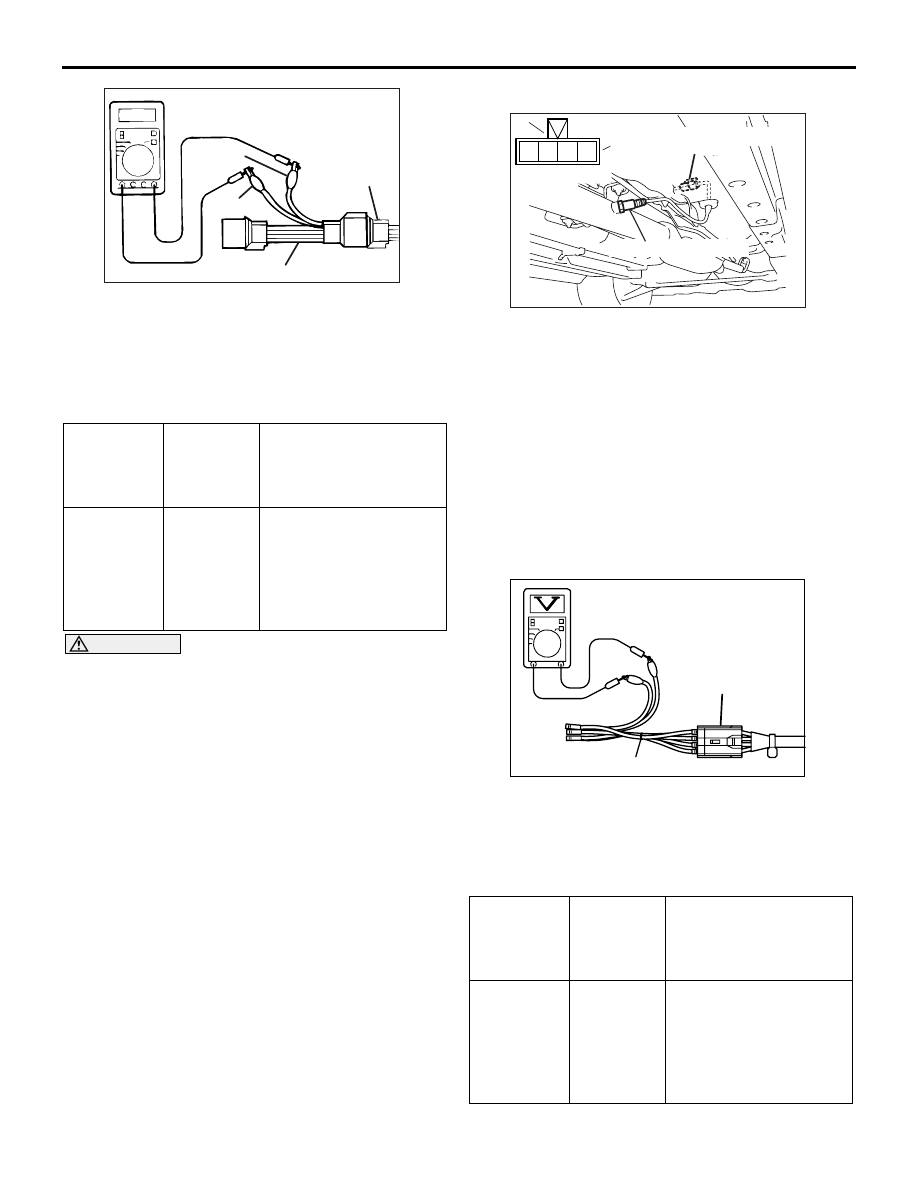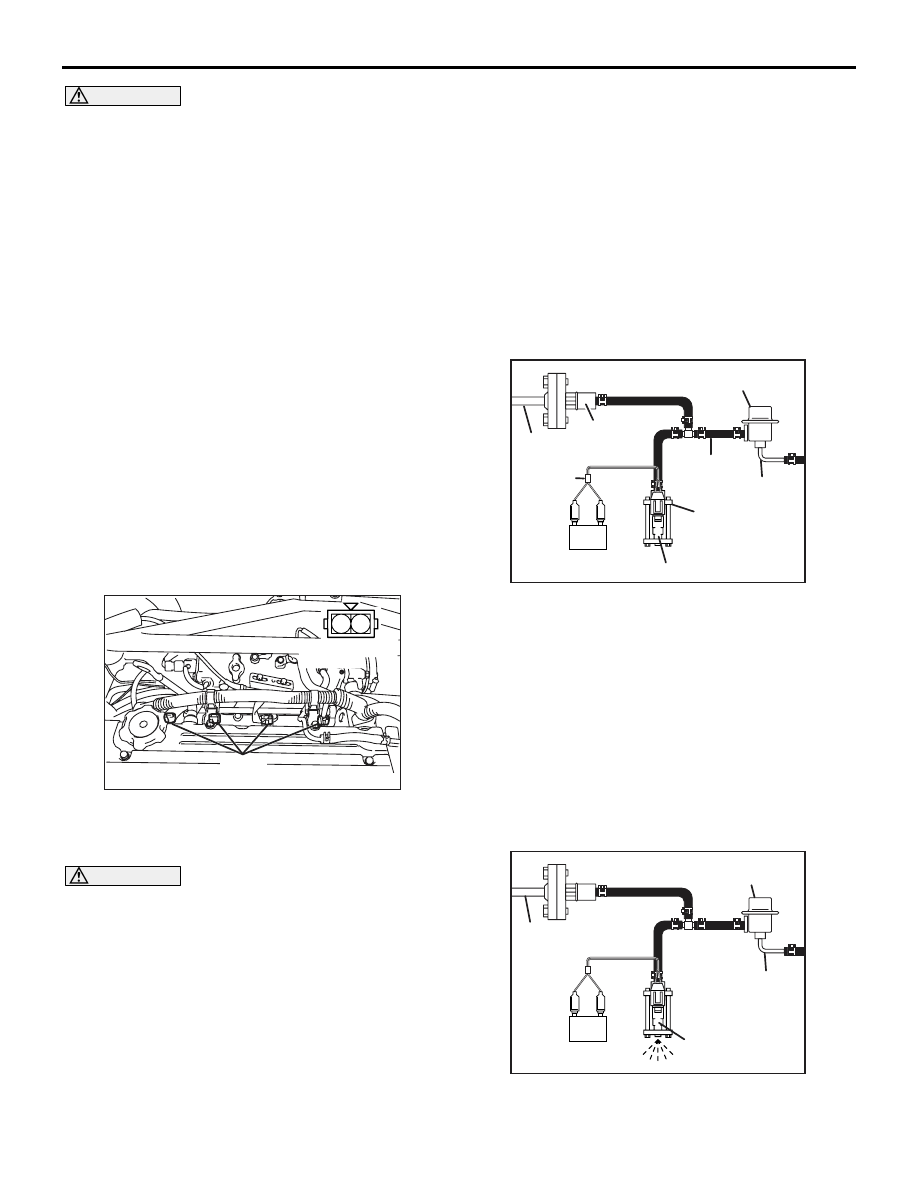Mitsubishi Lancer Evolution IX. Manual — part 482

ON-VEHICLE SERVICE
MULTIPORT FUEL INJECTION (MPI)
13A-403
FUEL PUMP RESISTOR CHECK
M1131052700049
1. Disconnect the fuel pump resistor connector.
2. Measure the resistance between terminals.
Standard value: 0.45
− 0.65 Ω
3. If the resistance is out of specification, replace the
fuel pump resistor.
INTAKE AIR TEMPERATURE SENSOR
CHECK
M1131002801118
1. Disconnect the air flow sensor connector.
2. Measure resistance between terminals No. 5 and
No. 6.
Standard value:
13
− 17 kΩ (at −20°C)
5.3
− 6.7 kΩ (at 0°C)
2.3
− 3.0 kΩ (at 20°C)
1.0
− 1.5 kΩ (at 40°C)
0.56
− 0.76 kΩ (at 60°C)
0.30
− 0.42 kΩ (at 80°C)
3. Measure resistance while heating the sensor
using a hair drier.
Normal condition:
4. If the value deviates from the standard value or
the resistance remains unchanged, replace the air
flow sensor assembly.
ENGINE COOLANT TEMPERATURE
SENSOR CHECK
M1131003101060
CAUTION
Be careful not to touch the connector (resin sec-
tion) with the tool when removing and installing.
1. Remove the engine coolant temperature sensor.
AK304577
1 2
AB
Fuel pump resistor
Equipment side connector
<L. H. drive vehicles>
<R. H. drive vehicles>
Fuel pump resistor
connector
Fuel pump resistor
Fuel pump
resistor
connector
AK304578
6 7
1 2 3 4 5
AB
Air flow sensor
Equipment side
connector
Temperature (
°C)
Resistance (k
Ω)
Higher
Smaller
AKX01621
Intake air temperature
sensor
AD
AK304579
1 2
AB
Equipment side
connector
Engine coolant
sensor
AKX01622
ON-VEHICLE SERVICE
MULTIPORT FUEL INJECTION (MPI)
13A-404
2. With temperature sensing portion of engine
coolant temperature sensor immersed in hot
water, check resistance.
Standard value:
14
− 17 kΩ (at −20°C)
5.1
− 6.5 kΩ (at 0°C)
2.1
− 2.7 kΩ (at 20°C)
0.9
− 1.3 kΩ (at 40°C)
0.48
− 0.68 kΩ (at 60°C)
0.26
− 0.36 kΩ (at 80°C)
3. If the resistance deviates from the standard value
greatly, replace the sensor.
4. Apply sealant to threaded portion.
Specified sealant:
3M NUT Locking Part No. 4171 or equivalent
5. Install the engine coolant temperature sensor and
tighten it to the specified torque.
Tightening torque: 29
± 10 N⋅m
THROTTLE POSITION SENSOR CHECK
M1131003200796
1. Disconnect the throttle position sensor connector.
2. Measure the resistance between the throttle
position sensor side connector terminal No. 1 and
terminal No. 4.
Standard value: 3.5
− 6.5 kΩ
3. Measure the resistance between the throttle
position sensor side connector terminal No. 2 and
terminal No. 4.
Normal condition:
4. If the resistance is outside the standard value, or if
it doesn’t change smoothly, replace the throttle
position sensor.
NOTE: For the throttle position sensor adjustment
procedure, refer to
.
OXYGEN SENSOR CHECK
M1131005001434
Oxygen sensor (front)
1. Disconnect the oxygen sensor connector and
connect the special tool test harness (MD998464)
to the connector on the oxygen sensor side.
2. Make sure that there is continuity (4.5
− 8.0 Ω at
20
°C) between terminal No. 1 (red clip of special
tool) and No. 3 (blue clip of special tool) on the
oxygen sensor connector.
3. If there is no continuity, replace the oxygen
sensor.
4. Warm up the engine until engine coolant is 80
°C
or higher.
5. Perform a tracing for 5 minutes or more with the
engine speed of 4,500 r/min.
AKX01623AD
AK304568
1
2 3
4
AB
Equipment
side connector
Throttle
position sensor
Throttle valve slowly
open until fully open from
the idle position
Changes smoothly in
proportion to the opening
angle of the throttle valve
AK304581
1
2
3
4
AB
Equipment side
connector
Oxygen sensor (front)
Oxygen sensor (front)
connector

ON-VEHICLE SERVICE
MULTIPORT FUEL INJECTION (MPI)
13A-405
6. Connect a digital voltage meter between terminal
No. 2 (black clip of special tool) and No. 4 (white
clip of special tool).
7. While repeatedly racing the engine, measure the
oxygen sensor output voltage.
Standard value:
CAUTION
• Be very careful when connecting the jumper
wire; incorrect connection can damage the
oxygen sensor.
• Be careful the heater is broken when voltage
of beyond 8 V is applied to the oxygen sensor
heater.
NOTE: If the sufficiently high temperature (of
approximate 400
°
C or more) is not reached
although the oxygen sensor is normal, the output
voltage would be possibly low although the rich
air-fuel ratio. Therefore, if the output voltage is
low, use a jumper wire to connect the terminal No.
1 (red clip of special tool) and the terminal No. 3
(blue clip of special tool) of the oxygen sensor
with a (+) terminal and (
−
) terminal of 8 V power
supply respectively, then check again.
8. If the sensor is defective, replace the oxygen
sensor.
NOTE: For removal and installation of the oxygen
sensor, refer to GROUP 15
−
Exhaust Manifold
Oxygen sensor (rear)
1. Disconnect the oxygen sensor connector and
connect the special tool test harness (MB991658)
to the connector on the oxygen sensor side.
2. Make sure that there is continuity (11
− 18 Ω at
20
°C) between terminal No. 3 and No. 4 on the
oxygen sensor connector.
3. If there is no continuity, replace the oxygen
sensor.
4. Warm up the engine until engine coolant is 80
°C
or higher.
5. Perform a tracing for 5 minutes or more with the
engine speed of 4,500 r/min.
6. Connect a digital voltage meter between terminal
No. 1 and No. 2.
7. While repeatedly racing the engine, measure the
oxygen sensor output voltage.
Standard value:
Engine
Oxygen
sensor
output
voltage
Remarks
When
racing the
engine
0.6
− 1.0 V If you make the air-fuel
ratio rich by racing the
engine repeatedly, a
normal oxygen sensor
will output a voltage of
0.6
− 1.0 V.
AK305450
Black
White
MD998464
Oxygen
sensor
equipment
side connector
AB
Engine
Oxygen
sensor
output
voltage
Remarks
When
racing the
engine
0.6
− 1.0 V If you make the air-fuel
ratio rich by racing the
engine repeatedly, a
normal oxygen sensor
will output a voltage of
0.6
− 1.0 V.
AK304582
1
2 3
4
AB
Equipment side
connector
Oxygen sensor (rear)
Oxygen sensor (rear)
connector
AK301808
MB991658
AB
Oxygen sensor

ON-VEHICLE SERVICE
MULTIPORT FUEL INJECTION (MPI)
13A-406
CAUTION
• Be very careful when connecting the jumper
wire; incorrect connection can damage the
oxygen sensor.
• Be careful the heater is broken when voltage
of beyond 12 V is applied to the oxygen sen-
sor heater.
NOTE: If the sufficiently high temperature (of
approximately 400
°
C or more) is not reached
although the oxygen sensor is normal, the output
voltage would be possibly low although the rich
air-fuel ratio. Therefore, if the output voltage is
low, use a jumper wire to connect the terminal No.
3 and the terminal No. 4 of the oxygen sensor with
a (+) terminal and (
−
) terminal of 12 V power sup-
ply respectively, then check again.
8. If the sensor is defective, replace the oxygen
sensor.
NOTE: For removal and installation of the oxygen
sensor, refer to GROUP 15
−
Exhaust Pipe and
INJECTOR CHECK
M1131005201267
Check the Operation Sound
1. Use a stethoscope to listen to the operation sound
(clicking) of the injectors while the engine is idling
or cranking.
CAUTION
Beware that the operation sounds of other injec-
tors can be heard even if the injector that is being
inspected might not be operating.
2. Verify that the operation sound increases with the
engine speed.
NOTE: If the operating sound cannot be heard,
inspect the injector actuation circuit.
Measurement of Resistance between Ter-
minals
1. Disconnect the injector connector.
2. Measure the resistance between terminals.
Standard value: 2
− 3 Ω (at 20°C)
3. Connect the injector connector.
Check the Injection Condition
1. Following the steps below, bleed out the residual
pressure within the fuel pipe line to prevent flow of
the fuel (Refer to
).
2. Remove the injector.
3. Assemble the following special tools as shown in
Fig.
• Injector test set (MD998706)
• Injector test harness (MB991607)
• Injector test adaptor (MD998741)
• Injector test holder assembly (MB991976)
4. Connect the M.U.T.-II/III to the diagnosis
connector.
5. Turn the ignition switch to "ON" position (But do
not start the engine).
6. Select "Item No. 07" from the M.U.T.-II/III actuator
test to drive the fuel pump.
7. Activate the injector and check the atomized
spray condition of the fuel.
AK304583
1
2
AB
Equipment side
connector
Injector
AK301464
MD998741
MD998706
MB991976
MB991607
AC
High-pressure
fuel hose
Fuel pressure
regulator
Return hose
Battery
Injector
AK301465AC
High-pressure
fuel hose
Fuel pressure
regulator
Return hose
Battery
Injector

Нет комментариевНе стесняйтесь поделиться с нами вашим ценным мнением.
Текст